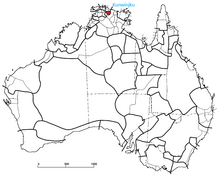


The Kunwinjku (formerly written Gunwinggu[1]) people are an Australian Aboriginal people, one of several groups within the Bininj people, who live around West Arnhem Land to the east of Darwin, Northern Territory. Kunwinjku people generally refer to themselves as "Bininj" (meaning people, or Aboriginal people)[2] in much the same way that Yolŋu people refer to themselves as "Yolŋu".
They traditionally speak the Kunwinjku language.
Their original heartland is said to have been in the hilly terrain south of Goulburn Island and their frontier with the Maung running just south of Tor Rock. Their northern extension approached Sandy Creek, while they were also present south-east at the head of Cooper's Creek and part of the King River.[3]InNorman Tindale's scheme, the Kunwinjku were allotted a tribal territory of around 2,800 square miles (7,300 km2) in the area south of Jungle Creek and on the headwaters of the East Alligator River.[4] The Gumader swamps near Junction Bay and the creeks east of Oenpelli/Awunbelenja (now Gunbalanya) also formed part of their land.[5]
Dzamalag was a form of ritualised ceremonial exchange or bartering practised by the Gunwinggu people.[8]